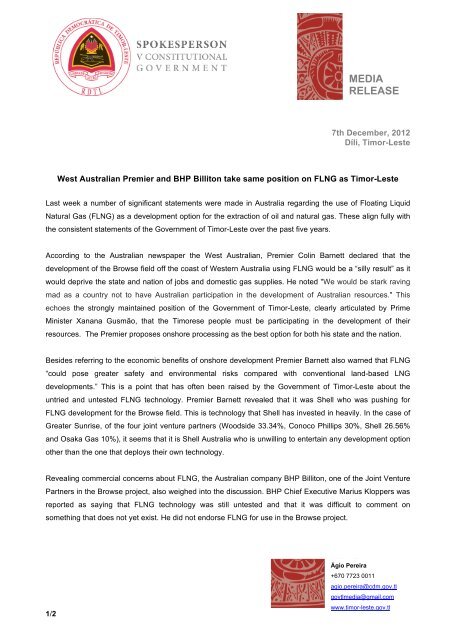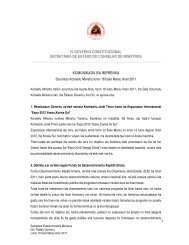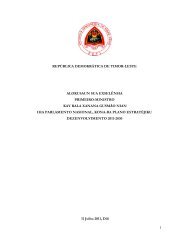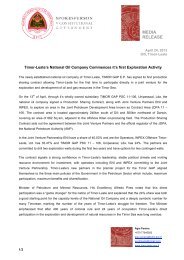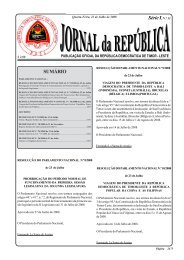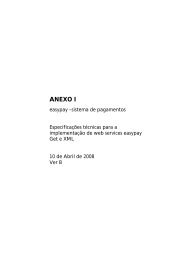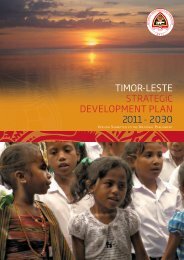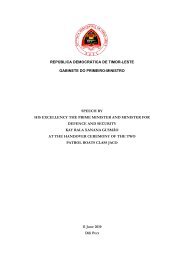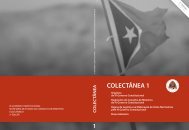MEDIA RELEASE
MEDIA RELEASE
MEDIA RELEASE
You also want an ePaper? Increase the reach of your titles
YUMPU automatically turns print PDFs into web optimized ePapers that Google loves.
<strong>MEDIA</strong><strong>RELEASE</strong>7th December, 2012Díli, Timor-LesteWest Australian Premier and BHP Billiton take same position on FLNG as Timor-LesteLast week a number of significant statements were made in Australia regarding the use of Floating LiquidNatural Gas (FLNG) as a development option for the extraction of oil and natural gas. These align fully withthe consistent statements of the Government of Timor-Leste over the past five years.According to the Australian newspaper the West Australian, Premier Colin Barnett declared that thedevelopment of the Browse field off the coast of Western Australia using FLNG would be a “silly result” as itwould deprive the state and nation of jobs and domestic gas supplies. He noted "We would be stark ravingmad as a country not to have Australian participation in the development of Australian resources." Thisechoes the strongly maintained position of the Government of Timor-Leste, clearly articulated by PrimeMinister Xanana Gusmão, that the Timorese people must be participating in the development of theirresources. The Premier proposes onshore processing as the best option for both his state and the nation.Besides referring to the economic benefits of onshore development Premier Barnett also warned that FLNG“could pose greater safety and environmental risks compared with conventional land-based LNGdevelopments.” This is a point that has often been raised by the Government of Timor-Leste about theuntried and untested FLNG technology. Premier Barnett revealed that it was Shell who was pushing forFLNG development for the Browse field. This is technology that Shell has invested in heavily. In the case ofGreater Sunrise, of the four joint venture partners (Woodside 33.34%, Conoco Phillips 30%, Shell 26.56%and Osaka Gas 10%), it seems that it is Shell Australia who is unwilling to entertain any development optionother than the one that deploys their own technology.Revealing commercial concerns about FLNG, the Australian company BHP Billiton, one of the Joint VenturePartners in the Browse project, also weighed into the discussion. BHP Chief Executive Marius Kloppers wasreported as saying that FLNG technology was still untested and that it was difficult to comment onsomething that does not yet exist. He did not endorse FLNG for use in the Browse project.1/2Ágio Pereira+670 7723 0011agio.pereira@cdm.gov.tlgovtlmedia@gmail.comwww.timor-leste.gov.tl
BHP is concerned about cost blowouts that have hit a number of LNG projects. Timor-Leste has maintainedthat cost blowouts, which are ultimately a cost to the People of Timor-Leste, are a serious concern withFLNG. Consequently much talk to date about economic viability and cost margins regarding FLNG is low onfact and high on speculation.A proposed pipeline to the processing plant for the Browse field would travel approximately 385kms. Thepipeline from Greater Sunrise to the shores of Timor-Leste is anticipated to be around 230 kms. In a directline the distance is only 150kms. Shell’s argument that FLNG is for stranded fields is not applicable to theGreater Sunrise field.It is clear from these recent statements, that Timor-Leste is not alone in expressing its concerns about FLNGand that some Government Leaders in Australia, like Timor-Leste, are willing to express their concernswhen it comes to protecting and promoting the welfare of their own citizens. ENDSÁgio Pereira+670 7723 0011agio.pereira@cdm.gov.tlgovtlmedia@gmail.comwww.timor-leste.gov.tl


